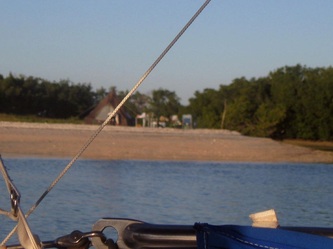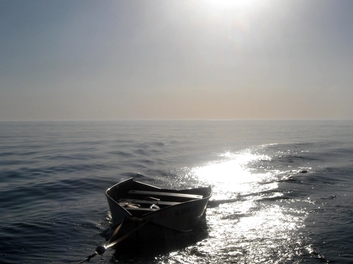
Upon arriving back in Bradenton, we had exactly a week to get the boat ready and get moving. We packed a lot into that week, and then early on the morning of the 7th, we headed out of the marina to make our way down the west coast of Florida. By January 16th, we had traveled 250 miles south down the West Coast of Florida, arriving in the Keys, just ahead of the front that was bringing an end to more than a week of unseasonably warm weather and the SE winds that had foiled our attempts to sail most of our trip south. Since we were now planning to head up the Keys, it put our direction mostly northeast, which was now the wind direction in the forecast at least a week ahead. It figures.
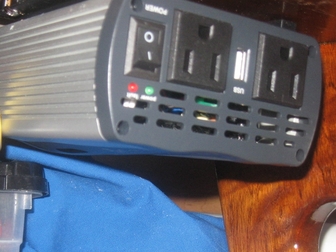
Our replacement inverter installed under the stairs
Getting Ready to Leave
We had started a number of projects during our stay at Riviera Dunes Marina in Bradenton. During our last week, we put the finishing touches on many of them. Before we had been back in town a full hour, Dave had installed a replacement inverter under the companionway stairs, to enable us to generate AC power from the batteries for things like charging the computer and, equally important, running the blender, which we brought back to the boat from storage in anticipation.
We had started a number of projects during our stay at Riviera Dunes Marina in Bradenton. During our last week, we put the finishing touches on many of them. Before we had been back in town a full hour, Dave had installed a replacement inverter under the companionway stairs, to enable us to generate AC power from the batteries for things like charging the computer and, equally important, running the blender, which we brought back to the boat from storage in anticipation.
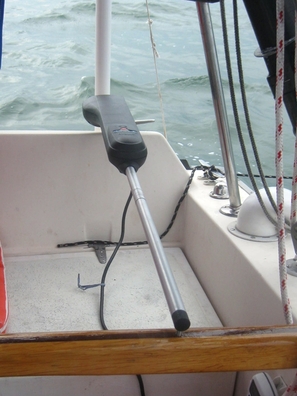
One of the bigger upgrades we had been planning for Orion Jr was to install a tiller pilot. This is an autopilot for a tiller. It is mounted perpendicular to the tiller and uses a motor to control the boat's steering. The controls allow you to choose a heading which it will maintain or to tie into a route on your chartplotter. Given the size of our cockpit, Dave determined that only Simrad's model would span the distance from the side of the cockpit to the tiller.
Since we had to drill a new hole for the power plug, we decided to use this opportunity to move the remote mike to a more centrally-located position and higher on the transom. Dave took over its original location to install the socket for the tiller pilot. He then wired it for power and made the NEMA connections to the chartplotter to allow it to receive route information. With the wiring done, he then needed to mount the control arm, which required a hole for the pin on the side wall and installing a pin on the tiller to connect to the driving rod. After some careful measurements, Dave got some help from his brother-in-law (and his garage full of tools) to drill a hole in the starboard aft cleat and a hole to receive the pin in the tiller. With the holes drilled, Dave epoxied the pin in place in the tiller and fitted the control arm in place. It fit perfectly and responded as designed to the control buttons, extending or contracting as directed. Now we just had to get underway to put it to the test. As we sailed across Sarasota Bay our first day out, the tiller pilot took the helm and took over the driving. We've used for many hours since.
Since we had to drill a new hole for the power plug, we decided to use this opportunity to move the remote mike to a more centrally-located position and higher on the transom. Dave took over its original location to install the socket for the tiller pilot. He then wired it for power and made the NEMA connections to the chartplotter to allow it to receive route information. With the wiring done, he then needed to mount the control arm, which required a hole for the pin on the side wall and installing a pin on the tiller to connect to the driving rod. After some careful measurements, Dave got some help from his brother-in-law (and his garage full of tools) to drill a hole in the starboard aft cleat and a hole to receive the pin in the tiller. With the holes drilled, Dave epoxied the pin in place in the tiller and fitted the control arm in place. It fit perfectly and responded as designed to the control buttons, extending or contracting as directed. Now we just had to get underway to put it to the test. As we sailed across Sarasota Bay our first day out, the tiller pilot took the helm and took over the driving. We've used for many hours since.
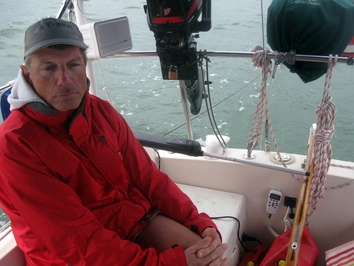
Look Ma! No hands.
When we sailed for the first time on our way north to Venice, we noticed the port cleat for the headsail sheet was loose. After trying to tighten it failed, we removed it and discovered one of the stainless steel bolts had corroded and was fused with the aluminum cleat. We tried WD40 to no avail, then soaking in vinegar, which also didn't work. Once again, Dave's brother-in-law came to the rescue. He heated the cleat in the oven and then punched the bolt out easily. When we re-installed it, we made sure we coated the bolt with Lanacote, which provides a barrier between the 2 metals, eliminating the potential for galvanic corrosion that salt water introduces to dissimilar metals.
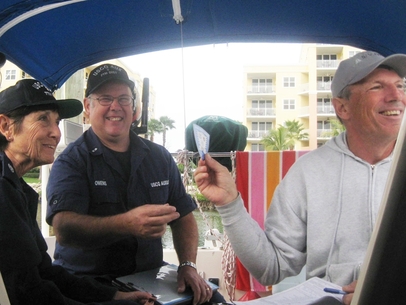
Orion Jr is certified for 2013
Dave also finalized the installation of the new solar panel. Recognizing that the industry is standardizing around an MC4 connector, he wired the new panel into the batteries using these connectors. And while drilling a hole in the tiller for the tiller pilot, Dave drilled a hole to receive a tiller handle that had come with the boat, but wasn't installed because it was too short. (The tiller handler has a rubber ball on one end that locks into the side and a pin in the other end that attaches to the tiller. When locked into the side wall, the tiller won't move) Since we needed something to keep the rudder from moving while at anchor, Dave decided to go ahead and install the too short version for now, while we continue to look for the right one. (The fitting on the tiller won't change.) Finally, we finished the routine chores that get us travel-ready: provisioning, laundry, topping off fuel and water, changing the oil in the generator, cleaning the deck, re-assembling the dinghy, and getting a Vessel Safety Inspection. By the morning of the 7th, we had the chores behind us and we were ready to set sail.
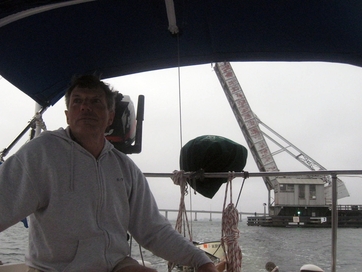
Dave guides us through the now-open RR bridge on the Manatee R
Moving Again
We picked a less than stellar day to leave Bradenton, but our month was up. After a week of beautiful weather while we sat at the dock, it was our luck that on our first travel day the skies were threatening rain and the northeast wind was blowing strong even in the marina's protected basin. It was going to be a chilly trip. With Sarasota as our destination, we headed out shortly after sun up. However, before the first hour was out, we had turned around and were headed back to the marina. Why? Immediately downriver from the marina were 3 bridges –- a fixed 40 ft bridge, an opening RR bridge and a fixed 41 ft bridge. As we approached the 3 bridges, we were shocked to see the RR bridge down. We had heard no train whistles, and there were no trains in sight. We tried hailing the bridge on several channels, but got no response. Finally, we called the Coast Guard, who responded that the bridge had reported electrical problems and they didn't know when it would re-open. So, were we stuck for hours? Days? Weeks? Who knew. We called the marina and told them we were headed back to our slip. But before we made it to the channel, Dave turned around to see the RR bridge opening. We turned around quickly and made a beeline for the bridge to clear it before it might close again. Once through, we breathed a sigh of relief. We used the Northeast winds to sail down the river into Tampa Bay before turning into the ICW. As we approached the narrow entrance which crossed the shoal before the ICW, we were surfing down the waves which had built across the long fetch across Tampa Bay. By mid-afternoon however, the winds had mellowed enough that we pulled out the headsail, turned off the motor and had a leisurely sail across Sarasota Bay to Marina Jack under the now sunny skies. The day that had started so poorly ended far better as we joined Dave's sister Wendy and her in-laws at Two Senoritas in downtown Sarasota for a delicious Mexican meal.
We picked a less than stellar day to leave Bradenton, but our month was up. After a week of beautiful weather while we sat at the dock, it was our luck that on our first travel day the skies were threatening rain and the northeast wind was blowing strong even in the marina's protected basin. It was going to be a chilly trip. With Sarasota as our destination, we headed out shortly after sun up. However, before the first hour was out, we had turned around and were headed back to the marina. Why? Immediately downriver from the marina were 3 bridges –- a fixed 40 ft bridge, an opening RR bridge and a fixed 41 ft bridge. As we approached the 3 bridges, we were shocked to see the RR bridge down. We had heard no train whistles, and there were no trains in sight. We tried hailing the bridge on several channels, but got no response. Finally, we called the Coast Guard, who responded that the bridge had reported electrical problems and they didn't know when it would re-open. So, were we stuck for hours? Days? Weeks? Who knew. We called the marina and told them we were headed back to our slip. But before we made it to the channel, Dave turned around to see the RR bridge opening. We turned around quickly and made a beeline for the bridge to clear it before it might close again. Once through, we breathed a sigh of relief. We used the Northeast winds to sail down the river into Tampa Bay before turning into the ICW. As we approached the narrow entrance which crossed the shoal before the ICW, we were surfing down the waves which had built across the long fetch across Tampa Bay. By mid-afternoon however, the winds had mellowed enough that we pulled out the headsail, turned off the motor and had a leisurely sail across Sarasota Bay to Marina Jack under the now sunny skies. The day that had started so poorly ended far better as we joined Dave's sister Wendy and her in-laws at Two Senoritas in downtown Sarasota for a delicious Mexican meal.

Exiting Sarasota's Big Pass inlet to the Gulf
Leaving Sarasota the next morning, we decided to take advantage of a favorable forecast to head outside in the Gulf and sail down to Venice. We called BoatUS for some local information about Sarasota's Big Pass inlet. The Coast Guard no longer maintains the marks at this inlet because of shoaling. However, the Sarasota Yacht Club took over the job. Dave had used the yacht club's waypoints for a few of them, but we wanted to be sure we understood how to navigate the shoal and that we should be able to navigate through. After a conversation with Boat US and a report from a boat in the inlet, we decided to go for it. It turned out to be a good decision. The passage was easy and we were quickly under full sail headed down the coast, with dolphins playing in our bow wake. As we made our way toward Venice, we were unhappy with the options for anchoring there. This prompted another conversation with Boat US about our options, which introduced us to another inlet, Stump Pass, a little further south. It wasn't something many boats could do, but with our shallow draft, it was a reasonable option, and there was an anchorage just inside the inlet. As the sun began drop into the late afternoon sky, we picked up the two outer marks as they had been described and motored over a flat sea into the inlet. After rounding the point into the anchorage, we found we had it to ourselves, sharing it only with some sea birds and a fishing boat or two passing though.
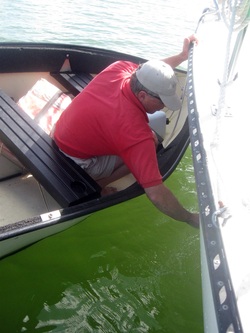
Dave cleans the waterline at Cayo Costa
Since It was a much shorter run to Cayo Costa, our next stop, we made it a late start out of Stump Pass. That meant a lower tide state, but we were still fine. The winds picked up, but as would become a recurring theme on this trip, they were mostly too close to our direction to sail to. After a bouncy trip in the inlet with wind over current, we dropped anchor in Cayo Costa in early afternoon. We weren't sure how long to stay, since this is one of our favorite spots, but after a conversation with Pat and Fred, who were heading to Miami for the end of January, we made a decision which would shape our travels for the next week. We would head south around the Keys and meet them there. That meant a short stay in Cayo Costa and a series of hops down the coast. The winds weren't in the best direction, but they were mostly light, which meant we could do it without too much impact on our speed. So, at sunrise on the 11th, we pulled anchor and headed out for Fort Myers Beach beginning what would become a week of long travel days with stops only long enough to get supplies and head out again.
We managed to pick up a mooring around 1pm, snagging the closest one to the dinghy dock. Alright! Once secured, we headed in to check-in and get some fuel. However, we ran into a stumbling block when we checked in. The mooring we had was supposed to have been marked as unavailable, but wasn't. The irritating thing was that Cathy had called in to see which moorings were available and was told to “take any one”. So, we went back to the boat and moved to the farthest ball in the east field, which was now a long dinghy ride in. After a run to Publix that took over 2 hours because of much-delayed bus, we made another round trip to the boat to drop off the food and get stuff for showers. By 9pm, we were back on board and Cathy made a quick dinner before we crashed. Tomorrow was going to be another pre-dawn wake-up call to get underway at first light.
We managed to pick up a mooring around 1pm, snagging the closest one to the dinghy dock. Alright! Once secured, we headed in to check-in and get some fuel. However, we ran into a stumbling block when we checked in. The mooring we had was supposed to have been marked as unavailable, but wasn't. The irritating thing was that Cathy had called in to see which moorings were available and was told to “take any one”. So, we went back to the boat and moved to the farthest ball in the east field, which was now a long dinghy ride in. After a run to Publix that took over 2 hours because of much-delayed bus, we made another round trip to the boat to drop off the food and get stuff for showers. By 9pm, we were back on board and Cathy made a quick dinner before we crashed. Tomorrow was going to be another pre-dawn wake-up call to get underway at first light.
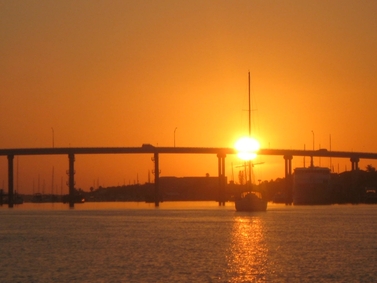
The sun rises behind us as we leave Fort Myers Beach
As we prepared to secure the dinghy early the next morning, we saw the current was running through the mooring field at a amazing clip, making the simple process of removing the outboard a challenge. Then when Cathy turned on the instruments, she was shocked to see less than 4 ft depth below us. We strategized how to leave the mooring field to find the deepest water. As we pulled out, we saw 3.5 feet before we got to the channel. In checking the tide tables, we were leaving at 0,8 foot below normal tide levels. (Leaving Cayo Costa the day before, we were at 1 ft below normal tides and saw some pretty skinny water leaving there as well.) And apparently, we weren't the only ones to be surprised by how shallow the water was. An Army Corps of Engineers ship was aground in the inlet as we made our way out to the Gulf. The rest of the day was uneventful. We were headed into the Capri Pass inlet off Marco Island by mid-afternoon and decided we had enough time to get to Goodland before sunset. This would give us Sunday to get the last fuel and water we would take on before the three-day Everglades trip.
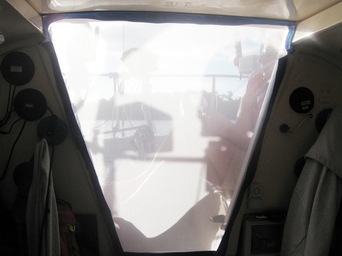
New netting in place in companionway
But as the sun set, instead of relaxing after a long day of travel, we found ourselves swatting at a flood of mosquitoes that poured into the boat through gaps in our netting. It had been good enough for last year's conditions, but it appeared that the warmer temperatures brought by all the southeast winds were also a boon for the bug population. That changed our plans for the next day. Instead of a quiet day provisioning, it became a marathon sewing session. Cathy re-cut the existing cover and bound it with sunbrella to hold velcro on the edge, which would provide a gap-free seal on the companionway. With 2 nights planned in the Everglades, we'd get a chance to test it well. Once the chores were out of the way, we dinghied into Goodland to Stan's, where we had a great burger and picked up some fresh fruit and vegetables at the produce stand. We were sad to learn that Stan had passed away this year, signalling the end of an era at this little town.
From Goodland, we headed into the Everglades, trying to make longer hops that would put us in position to jump to the Keys further east than Marathon. Since the closest anchorage east of Marathon was Matecumbe Bight, that would make for a run that might be too long to make in daylight, especially if the winds took our speed down. We had 3 options to choose from for the first night. Russell Pass, off Everglades City was not far enough away. Little Shark River was too far for us to make with the conditions. That left New Turkey Key, which was about 30 miles from Goodland. The only caution in the write-up was a 4 ft shoal at the entrance. That wasn't a problem for us. As we headed into the anchorage, we were 2 feet up on the tide and saw nothing less than 5 ft. We pulled up between Turkey Key and New Turkey Key (clever names) and dropped the anchor. We thought we were going to spend the night all by ourselves, but found shortly before sunset we had a neighbor. A couple motored up to the nearby beach and set up their tent. This turned out to be a pleasant stop. There was enough wind that the bugs stayed away long enough to grill out. And when the sun began to set, we put the new screen in place and the bugs seemed to be held at bay. BUT then we started getting bit. We looked at the screen, but could find no gaps. Where were they coming from? It turned out the wind had blown off the screen on the forward hatch. They were pouring in through the wide opening. It looked like Cathy would be back at the sewing machine.
From Goodland, we headed into the Everglades, trying to make longer hops that would put us in position to jump to the Keys further east than Marathon. Since the closest anchorage east of Marathon was Matecumbe Bight, that would make for a run that might be too long to make in daylight, especially if the winds took our speed down. We had 3 options to choose from for the first night. Russell Pass, off Everglades City was not far enough away. Little Shark River was too far for us to make with the conditions. That left New Turkey Key, which was about 30 miles from Goodland. The only caution in the write-up was a 4 ft shoal at the entrance. That wasn't a problem for us. As we headed into the anchorage, we were 2 feet up on the tide and saw nothing less than 5 ft. We pulled up between Turkey Key and New Turkey Key (clever names) and dropped the anchor. We thought we were going to spend the night all by ourselves, but found shortly before sunset we had a neighbor. A couple motored up to the nearby beach and set up their tent. This turned out to be a pleasant stop. There was enough wind that the bugs stayed away long enough to grill out. And when the sun began to set, we put the new screen in place and the bugs seemed to be held at bay. BUT then we started getting bit. We looked at the screen, but could find no gaps. Where were they coming from? It turned out the wind had blown off the screen on the forward hatch. They were pouring in through the wide opening. It looked like Cathy would be back at the sewing machine.
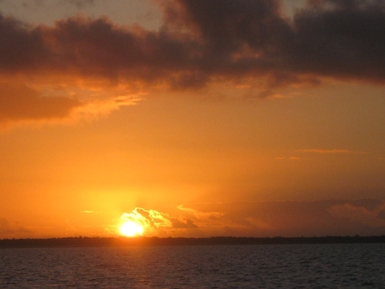
Sunrise off Cape Sable, the SW corner of Florida's peninsula
Leaving the next morning, we were once again seeing depths that were surprisingly low. If the tide tables were right, we were a foot up on the tide, but we saw depths as low as 3.5 ft. Could this be right? Obviously, Jr's 2.5 ft draft had no problem, but if the tide was really a foot up, even we would have to watch our approach in the wrong tide state. At any rate, as we headed out, we had to wait for sun-up to get the weather on the VHF. That would determine where we would stop for the night. The forecast supported our traveling beyond Little Shark River to anchor in the much less protected Cape Sable anchorage. If we were wrong about the wind direction, the fetch would encompass the entire Gulf of Mexico. By mid-afternoon, we found a spot about a mile off little Cape Sable and dropped the hook. Unlike our previous anchorages, the bugs here didn't wait until sunset to show up. How they found us so far off shore is anyone's guess. So, Cathy scrambled to finish the replacement screen for the forward hatch to ensure we could keep them out. It worked well, but these mosquitoes were certainly persistent. The next morning, as we were leaving, we covered ourselves from head to toe to keep from being eaten alive as Dave went out to pull anchor and Cathy manned the helm.
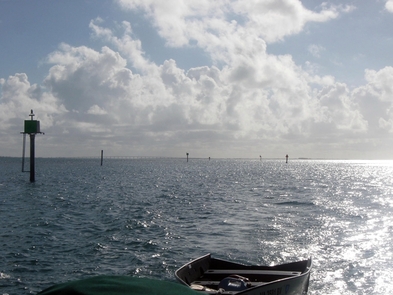
The Yacht Channel off Matecumbe Bight
As we rounded Cape Sable, we heard the cell phone ping to say that we had received a text message, the first activity in 2 days. We had received a message at New Turkey Key from our son, that must have been a fluke since we hadn't been able to respond. The message raised concerns, but we couldn't follow up. Luckily the text message we got off Cape Sable was an “all is OK” message from him which caused us to breathe a sigh of relief. The signal was enough for a brief call and then it dropped until we started to see the Keys on the horizon. So, our route to the Keys was the much shallower Yacht Channel toward Channel Five that we had mostly to ourselves. We pushed past Matecumbe bight to make it to Islamorada. After all this good weather, the next day's forecast was for a front to pass through. We wanted to get to Key Largo for an anchorage that would have protection from the strong NW winds.
So, as we rounded the bottom of Florida to head toward Miami, the southeast winds would vanish and be replaced by – what else – north to northeast winds. Because that was the direction we needed to go.
Family and Friends
New Year's Day was our first day back in Bradenton and was a busy one as we ended our travel and put the boat back in order. So, we were surprised in the midst of our settling in to be greeted on the dock by what turned out to be a fellow sailboater, Julie, who lived in the condos that overlooked the marina. She said she had been enjoying our Christmas lights all season and wanted to come say hello. She invited us up to meet her husband, Rick. We learned that their sailboat, Believe, is in Scotland, where they sailed to it a few years ago. They return each summer to explore new cruising grounds throughout Europe, planning to eventually end up in the Mediterranean. We had a wonderful evening learning of their adventures and hoped to see them again if we make it back to Bradenton in coming years.
January is a busy month for the extended family, starting with Dave's sister Wendy's birthday and ending with Dave's birthday. Being in Bradenton where Wendy's family was gathered, we had the rare opportunity to celebrate both events with family at our niece's house.
So, as we rounded the bottom of Florida to head toward Miami, the southeast winds would vanish and be replaced by – what else – north to northeast winds. Because that was the direction we needed to go.
Family and Friends
New Year's Day was our first day back in Bradenton and was a busy one as we ended our travel and put the boat back in order. So, we were surprised in the midst of our settling in to be greeted on the dock by what turned out to be a fellow sailboater, Julie, who lived in the condos that overlooked the marina. She said she had been enjoying our Christmas lights all season and wanted to come say hello. She invited us up to meet her husband, Rick. We learned that their sailboat, Believe, is in Scotland, where they sailed to it a few years ago. They return each summer to explore new cruising grounds throughout Europe, planning to eventually end up in the Mediterranean. We had a wonderful evening learning of their adventures and hoped to see them again if we make it back to Bradenton in coming years.
January is a busy month for the extended family, starting with Dave's sister Wendy's birthday and ending with Dave's birthday. Being in Bradenton where Wendy's family was gathered, we had the rare opportunity to celebrate both events with family at our niece's house.



